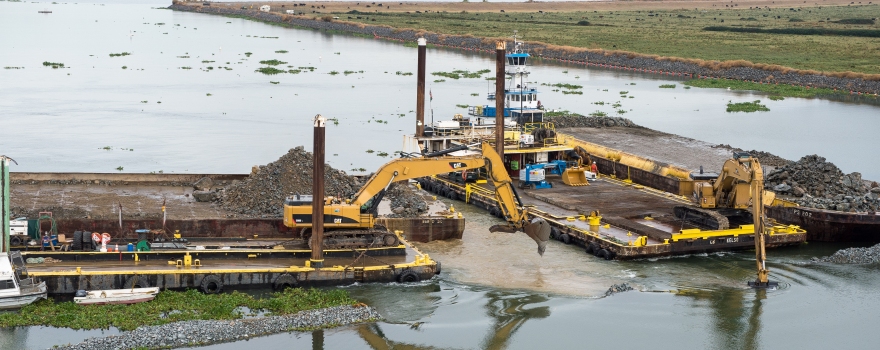
From the Department of Water Resources:
Work by the Department of Water Resources (DWR) to dismantle an emergency drought barrier that has spanned West False River between Jersey and Bradford islands since June is well underway, with breach in the barrier expected today.
The barrier was erected to block salt water from pushing into the central Sacramento-San Joaquin Delta from San Francisco Bay. The Delta’s water is used by 25 million Californians, including residents of the Delta and Contra Costa, Alameda and Santa Clara counties. DWR’s State Water Project and the federal Central Valley Project convey Delta water through their aqueducts to distant parts of the state.
A fourth year of drought made installation of the barrier necessary to preserve Delta water quality and conserve water in upstream reservoirs that otherwise would have been released to help block incoming tides of salty water from San Francisco Bay.
Permits issued to DWR for installation of the barrier require removal in November due to fishery and potential flood concerns.
Dismantling of the approximately 750-foot rock barrier began on September 8 and will be completed by mid-November. About 150,000 tons of large rocks (riprap) were used to build the barrier. Cranes have removed about 22,000 tons of riprap on the downstream side of the barrier along its length between the West False River’s banks, thereby narrowing the width while not lowering the barrier’s height.
Continued removal of the riprap this week should allow water to begin flowing over what remains of the barrier on or shortly after October 1. Dismantling of the remaining submerged portions of the barrier will continue until all of it is removed and boating restrictions are ended at that location. The removed riprap will be stored near Rio Vista for possible use if drought conditions continue and installation of an emergency drought barrier once again is deemed necessary to preserve water quality.
The barrier was an essential part of DWR’s strategy to maintain good water quality in the Delta and preserve water in upstream reservoirs to help keep young salmon cool enough to stay alive downstream of dams.
Paul Marshall, Chief of DWR’s Bay-Delta Office, said the barrier performed as expected based on DWR’s computer modeling. “The water users in the interior of the Delta, including many farmers and residents there, would have experienced much higher salinity without it,” he said. “The barrier has achieved what we intended, and having it go in by early June helped us to counter high tides experienced later that month.”
Additional information on the barrier and the considerations that led to its deployment can be found at DWR’s Emergency Drought Barriers website: http://water.ca.gov/waterconditions/emergencybarriers.cfm.
Additional information and a FAQ are contained in DWR’s May 8 press release on the project: http://www.water.ca.gov/news/newsreleases/2015/050815.pdf
To learn about all the actions the state has taken to manage our water system and cope with the impacts of the drought, visit Drought.CA.Gov.
Every Californian should take steps to conserve water. Find out how at SaveOurWater.com.
The State’s turf and toilet rebate program is explained at SaveOurWaterRebates.com.
More information on emergency drought barriers is available here.
Conservation – the wise, sparing use of water – remains California’s most reliable drought management tool. Each individual act of conservation, such as letting the lawn go brown or replacing a washer in a faucet to stop a leak, makes a difference over time.
The Department of Water Resources operates and maintains the State Water Project, provides dam safety and flood management and inspection services, assists local water districts in water management and water conservation planning, and plans for future statewide water needs.
 Get the Notebook blog by email and never miss a post!
Get the Notebook blog by email and never miss a post!
Sign up for daily emails and get all the Notebook’s aggregated and original water news content delivered to your email box by 9AM. Breaking news alerts, too. Sign me up!



